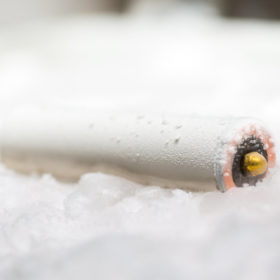
Scientists in the United States demonstrated a new route to improving battery performance. The group integrated a self-assembling layer which forms on the surface of the anode, preventing the formation of dendrites. While their prototype has a very short lifetime, the group is convinced approach could lead to better performing batteries, and is particularly promising for low temperature applications.
Of the many approaches to meeting demand for new, advanced energy storage technologies, lithium metal anodes are among the most promising. Lithium metal has several times the storage capacity of commonly used graphite and could allow for the development of much larger battery capacities.
However, it is a difficult material to work with. With most available liquid electrolytes it tends to form dendrites – branch like structures growing out the anode that threaten both performance and safety. Many see solid-state electrolytes as the only solution to safely integrate lithium metal anodes. Researchers, however, continue to investigate other possibilities.
A group led by Penn State University in the U.S. has found that by depositing an additional layer onto the surface of the anode, which serves to protect the lithium and prevent dendrites from forming. The active layer is deposited onto thin copper and comprises a a lithium fluoride-rich inner phase and amorphous outer layer.
The work integrating this layer into a battery is described in the paper Low-temperature and high-rate-charging lithium metal batteries enabled by a chemically active monolayer regulated interface, published in Nature Energy. “The key is to tune the molecular chemistry to self-assemble on the surface,” said Donghai Wang, professor of mechanical engineering at Penn State’s Battery and Energy Storage Technology Center. “The monolayer will provide a good solid electrolyte interface when charging, and protect the lithium anode.”
A battery incorporating the layer demonstrated a capacity of 2 milliamp hours per square centimeter, and a recharge time of 45 minutes at minus 15 degrees Celsius. And the layer was also shown to allow stable lithium deposition at temperatures as low as minus 60 degrees Celsius.
The battery, however, only remained stable for 200 cycles – a much shorter lifetime than would be needed to spark commercial interest. The group at Penn State, however, is convinced that this can be overcome and that its approach can be valuable in future energy storage applications.
“The key is that this technology shows an ability to form a layer when needed on time and decompose and spontaneously reform so it will stay on the copper and also cover the surface of the lithium,” said Wang. “Eventually it could be used for drones, cars, or some very small batteries used for underwater applications at low temperatures.”
Lắp đặt điện mặt trời Khải Minh Tech
https://ift.tt/2X7bF6x
0906633505
info.khaiminhtech@gmail.com
80/39 Trần Quang Diệu, Phường 14, Quận 3
Lắp đặt điện mặt trời Khải Minh Tech
https://ift.tt/2ZH4TRU
Không có nhận xét nào:
Đăng nhận xét